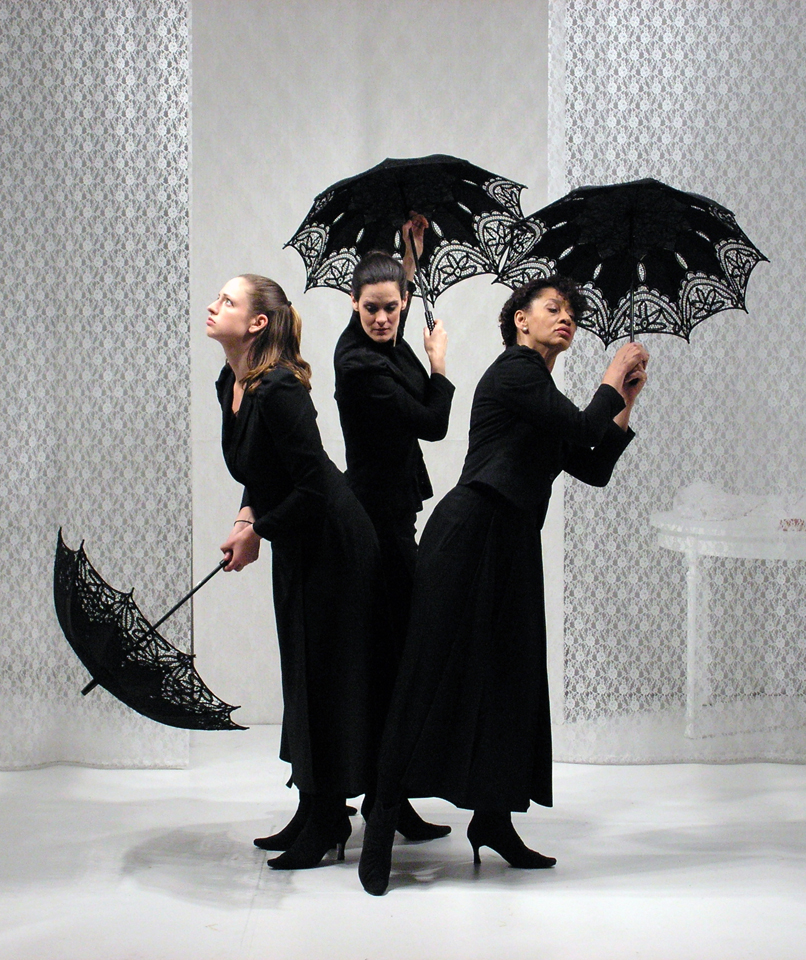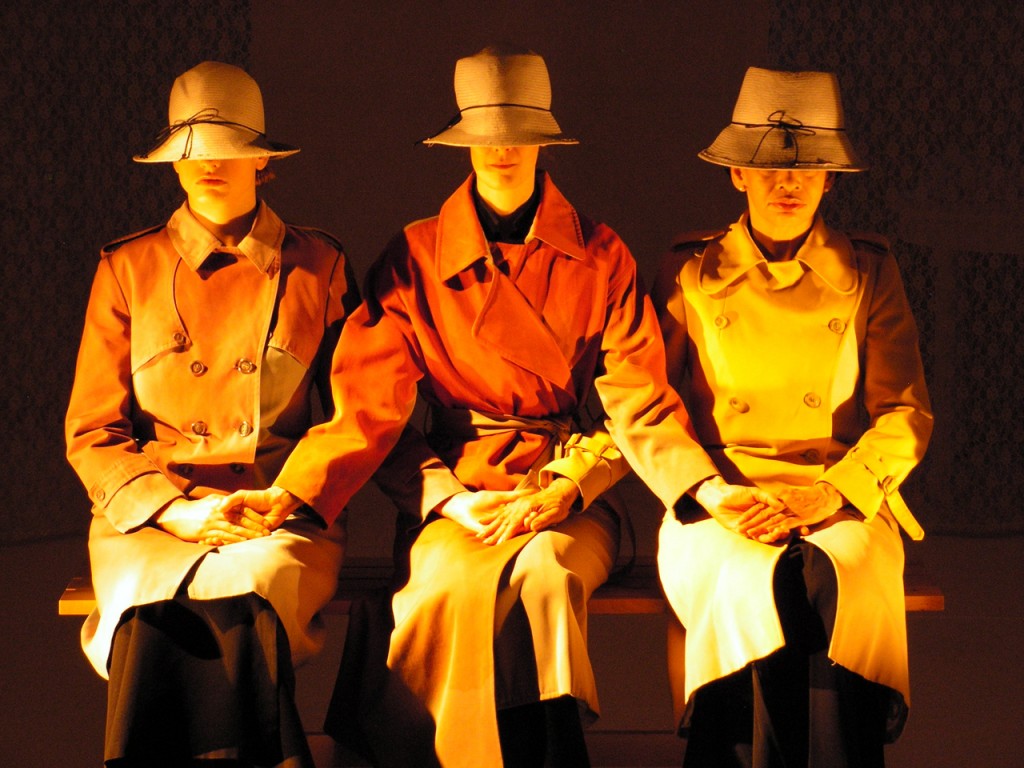
photo by Enrico Luttmann
Immature poets imitate; mature poets steal;
bad poets deface what they take, and good poets
make it into something better, or at least something different.
T.S. Eliot
The very idea of Three Sisters Come and Go was risky to begin with. A collaborative effort between the actors — Liza Cassidy, Claire Helene and Jackie Lowe –, the director, Orietta Crispino, and dramaturg, Marco Casazza, the play would open with Samuel Beckett’s “dramaticule,” Come and Go, and then the following scenes would be drawn from the texts of Anton Chekhov’s four major plays: Uncle Vanya, The Cherry Orchard, The Sea Gull, and The Three Sisters (which, to add to the complexity of the intertextuality, is a play based loosely on the three Bronte sisters), and the entirety of the play was to be governed by Structuralist philosopher and critic Julia Kristeva’s ideas about … something or other.
At this point, I stopped reading. It was Friday evening, and my mind lagged from the workweek. I shut down my work computer, left work, took the subway back over Manhattan Bridge, met someone for a drink, and told him I was worried about the play I was going to go see. The intertextuality of it was making me nervous the same way fusion restaurants do. Mixing together so many different stories could very well end up leaving a bad taste in one’s mouth.
We finished our drinks, and I went home, changed, headed back toward the subway, went back over Manhattan Bridge, disembarked at 14th Street, and walked toward TheaterLab.
As an ardent devotee of Chekhov, especially his short stories, part of me also wanted to be against Three Sisters Come and Go, out of loyalty and artistic principal, from the get-go; one simply cannot just ransack Chekhov’s plays for jewels and place them all together in one setting.

photo by Enrico Luttmann
I reached 6th Avenue, stopped for a quick espresso, and drank it in one gulp as I approached the theater. I went upstairs, picked up my ticket, met a friend and entered a tiny dark room with spare white walls and about twenty or so white chairs arranged to face a small stage where three actors sat, motionless, expressionless, and wearing hats that covered their eyes, as the audience settled. “Sure,” I thought, turning off my cell phone, “given the initial premise, Three Sisters Come and Go would at least be some kind of statement on art. But,” I worried, “would it succeed in being art?”
Once everyone was seated, the audience hushed and stared at the three figures on stage, who, if not for the floppy brims of their hats, would be staring back. The tiny room was suddenly transformed into a space where the three women directed questions about each other to each other in various configurations. This was Beckett’s Come and Go in its hypnotizing, though brief and simple, entirety—a kind of (forgive me), “Poststructuralist Gossip Girl,” I whispered to my friend after the dramaticule ended and the curtain dropped.
When the curtain opened again, three women dressed in black, holding black lace parasols stood starkly offset by the bright white of the stage and all its trimmings, complete with white lace curtains as a backdrop. This was just one instance of the performance piece quality of the scenes that would follow, with stark black, white and red colors running through the costume and set design so that the actors became almost ornamental.
I found that, as the play continued in a variety of postmodern situations, the scenes were surprisingly emotionally resonant, despite their spliced quality, largely due to the almost seamless acting of Liza Cassidy, Claire Helene and Jackie Lowe, whose characters succeeded in being at once characters and caricatures of their characters. One moment they’d have you sympathizing with their deepest sorrows, and the next moment they’d laugh off their own despair, and you’d laugh it off with them.
The play is composed of a number of scenes in which the characters converse with one another, as well as three solo pieces, giving each character a chance to embody a certain Chekhovian idea. The play ends with all three characters on stage as Liza Cassidy finishes her solo that parodies melancholia while feeling its sorrow: “Just back and forth…it becomes a living thing,” Cassidy says, “So beautiful and so sad / So beautiful so sad / Isn’t that enough.”
And as it ended, a similar question occurred to me, as my friend and I put on our jackets and walked downstairs and back onto 14th Street: Is that enough?
We paused on the sidewalk. “I think it is enough,” my friend said. I nodded. We started, again, to walk.
But I had another question. Would it be unfair to compare this Chekhov to Chekhov Chekhov?
“Yes,” she said. “It wasn’t trying to be Chekhov Chekhov.”
That was true. But was Three Sisters Come and Go defacing, to use T.S. Eliot’s term, the Chekhov it took, or did it succeed in making Chekhov something better than Chekhov?
“It wasn’t trying to be Chekhov,” my friend said again.
And still, I had another, larger question: Given the spliced quality of this play’s text and scenes, could a play subsist without a story?
“There was a story,” my friend said.
“No,” I said, “There wasn’t a story. There were themes. Can themes constitute a story?”
We walked further. Can a play rely only on themes and images to link its parts together the way a poem can?
I wasn’t sure. My friend wasn’t either. We walked further.
“We both enjoyed it, though, right?”
Crossing 3rd Avenue, we resoundingly agreed that we both really did enjoy Three Sisters Come and Go despite, or perhaps because of, its fragmented self-ironizing form. We then located and entered a crowded bar where we were meeting a third friend and ordered three beers.
As the three of us stood at the bar, suddenly I felt that everything—the NYU students, the bartenders, the filling of glasses, the emptying of glasses—had a Poststructural theatrical quality to it. Patrons would produce small wads of bills from their pockets, lean on the bar, shout a few words, and back over the bar would come tiny shot glasses on tiny silver trays, as if by themselves. Bills were produced, a figure would lean, a figure would shout, and back over the bar came the silver trays. And again: bills, lean, shout, bar, silver tray. Bills, lean, shout, bar, silver tray.
In Act One of Chekhov’s The Sea Gull, Konstantine Gavrilovich Trepleff, an aspiring young playwright, and his uncle, Peter Nikolaevich Sorin, discuss the theatre:
TREPLEFF: …theatre today is nothing but routine, convention. When the curtain goes up, and by artificial light in a room with three walls, these great geniuses, these priests of holy art, show how people eat, drink, make love, move about and wear their jackets; when they try to fish a moral out of these flat pictures and phrases, some sweet little bit anybody could understand and any fool take home; when in a thousand different dishes they serve me the same thing over and over, over and over, over and over—well, it’s then I run and run….
SORIN: But we can’t do without the theatre.
TREPLEFF: We must have new forms. New forms we must have, and if we can’t get them we’d better have nothing at all.
In the end, my friend and I agreed that any artist, living or dead, would be hard pressed to make Chekhov into something better than Chekhov, as Eliot suggests mature poets must do when stealing material, but Crispino and her talented cast of Three Sisters Come and Go certainly did succeed in making Chekhov something different.
~~~
THREE SISTERS COME AND GO May 12th through 27th Wednesdays through Saturdays at 8:00 pm Theaterlab (137 West 14th St. between 6th and 7th Ave) Additional performances are Monday, May 17; Monday, May 24; and Tuesday, May 25 at 8:00 pm. Tickets are Pay-What-You-Can for all Monday performances $20 for general admission and can be reserved by calling 212-352-3101 or clicking here






{ 1 comment… read it below or add one }
A fascinating look at Three Sisters Come And Go and a great reminder of just how much the theater means to the lives of so many people. Modern media has certainly changed the theater going experience and it is all too easy to lose sight of the fact that you still cannot beat a live performance.